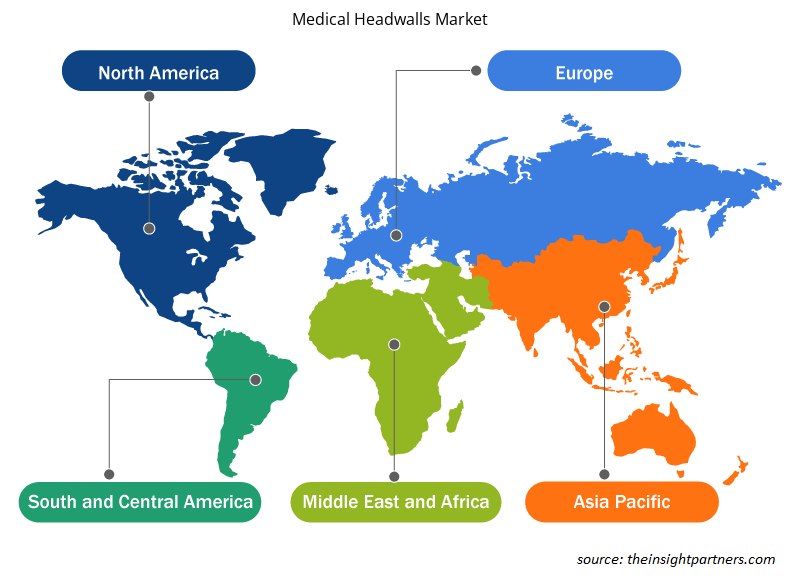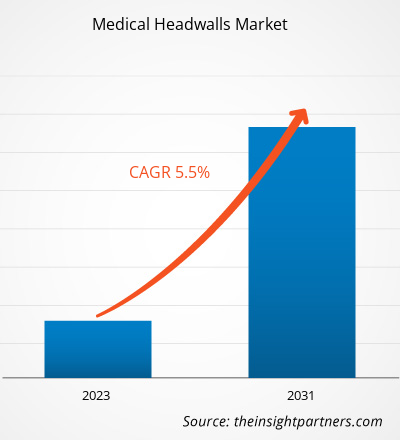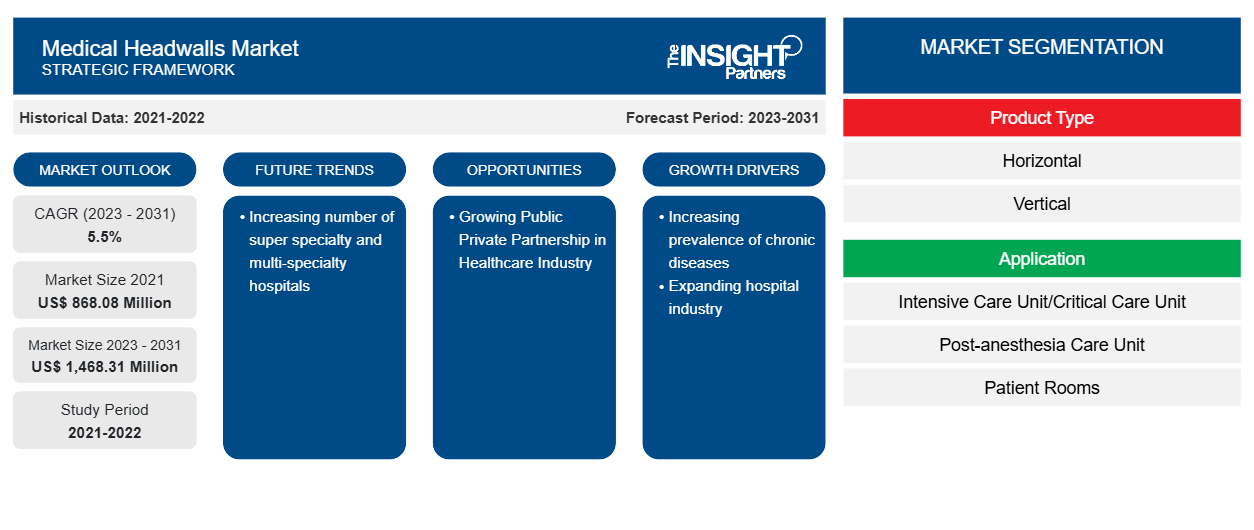El tamaño del mercado de los cabezales médicos en 2021 se situó en 868,08 millones de dólares estadounidenses y se prevé que alcance los 1.468,31 millones de dólares estadounidenses en 2031, frente a los XX mil millones de dólares estadounidenses de 2023. Se espera que el mercado registre una CAGR del 5,5 % entre 2023 y 2031. Es probable que el aumento del número de hospitales de especialidades múltiples y superespecializadas y el desarrollo de infraestructura sigan siendo tendencias clave del mercado de cabezales médicos.
Análisis del mercado de los cabezales médicos
Se prevé que el mercado de los cabezales médicos aumentará debido a factores como la creciente prevalencia de enfermedades crónicas y la expansión de la industria hospitalaria. Además, el aumento de las asociaciones público-privadas en la industria de la atención sanitaria contribuirá al crecimiento del mercado en los próximos años.
Descripción general del mercado de cabezales médicos
Los cabezales médicos son esenciales en hospitales, residencias de ancianos , hospitales especializados, hospitales multidisciplinarios y otros entornos. Los cabezales son sistemas de gestión de equipos montados en la pared que proporcionan servicios eléctricos y salidas de distribución horizontales para gases médicos como oxígeno, aire y vacío. Se prevé que los cabezales de hospital aumenten de forma constante en el mercado futuro. Sin embargo, la diversificación de productos, la reducción de costos y la optimización de la cadena de suministro siguen siendo fundamentales para la adopción generalizada del cabezal de hospital. Es probable que la creciente preferencia por la atención médica domiciliaria obstaculice el crecimiento del mercado.
Personalice este informe según sus necesidades
Obtendrá personalización en cualquier informe, sin cargo, incluidas partes de este informe o análisis a nivel de país, paquete de datos de Excel, así como también grandes ofertas y descuentos para empresas emergentes y universidades.
-
Obtenga las principales tendencias clave del mercado de este informe.Esta muestra GRATUITA incluirá análisis de datos, desde tendencias del mercado hasta estimaciones y pronósticos.
Impulsores y oportunidades del mercado de los muros de cabecera médicos
El aumento de los muros de contención médicos en todo el mundo favorece el crecimiento del mercado
El aumento del número de hospitalizaciones diarias ha dado lugar a un aumento de los hospitales y clínicas privadas. Los hospitales están pasando de la construcción de mamparas de protección con estructura de madera a un sistema de gestión de equipos montado en la pared para facilitar la experiencia al personal médico, los pacientes y los visitantes. Por tanto, la creciente prevalencia de enfermedades crónicas como las enfermedades cardiovasculares, el cáncer, la diabetes y otras son responsables del aumento del número de hospitalizaciones, lo que está impulsando el crecimiento del mercado de mamparas de protección médica.
Creciente colaboración público-privada en el sector sanitario
Health systems are becoming more integrated, addressing care requirements along the continuum and employing technology to improve delivery. PPPs focused on developing and rebuilding crucial hospital infrastructure; integrated PPPs incorporated clinical service delivery and private sector management methods to improve care quality and access to specialized care. For example, strengthen emergency hospital services in one of Brazil's most neglected districts. The local government engaged the International Finance Corp. (IFC), a member of the World Bank Group, to implement the PPP framework for the new hospital.
Medical Headwalls Market Report Segmentation Analysis
Key segments that contributed to the derivation of the medical headwalls market analysis are product type and application.
- Based on product type, the medical headwalls market is bifurcated into horizontal and vertical. The horizontal segment held a larger market share in 2023.
- By application, the market is divided into intensive care unit (ICU)/critical care unit (CCU), Post-anesthesia Care Unit (PACU), patient rooms, and other applications. The intensive care unit (ICU)/critical care unit (CCU) segment held the largest share of the market in 2023.
Medical Headwalls Market Share Analysis by Geography
The geographic scope of the medical headwalls market report is mainly divided into five regions: North America, Asia Pacific, Europe, Middle East & Africa, and South & Central America.
North America has dominated the medical headwalls market. The projected growth of the medical headwalls market is attributed to the presence of the large number of hospitals in the region. Moreover, the rising prevalence of chronic diseases, coupled with initiatives taken by the regional players, is anticipated to fuel market growth during the forecast period.
Medical Headwalls Market Regional Insights
The regional trends and factors influencing the Medical Headwalls Market throughout the forecast period have been thoroughly explained by the analysts at Insight Partners. This section also discusses Medical Headwalls Market segments and geography across North America, Europe, Asia Pacific, Middle East and Africa, and South and Central America.

- Get the Regional Specific Data for Medical Headwalls Market
Medical Headwalls Market Report Scope
| Report Attribute | Details |
|---|---|
| Market size in 2021 | US$ 868.08 Million |
| Market Size by 2031 | US$ 1,468.31 Million |
| Global CAGR (2023 - 2031) | 5.5% |
| Historical Data | 2021-2022 |
| Forecast period | 2023-2031 |
| Segments Covered |
By Product Type
|
| Regions and Countries Covered |
North America
|
| Líderes del mercado y perfiles de empresas clave |
|
Densidad de actores del mercado de cabeceras médicas: comprensión de su impacto en la dinámica empresarial
El mercado de cabezales médicos está creciendo rápidamente, impulsado por la creciente demanda de los usuarios finales debido a factores como la evolución de las preferencias de los consumidores, los avances tecnológicos y una mayor conciencia de los beneficios del producto. A medida que aumenta la demanda, las empresas amplían sus ofertas, innovan para satisfacer las necesidades de los consumidores y aprovechan las tendencias emergentes, lo que impulsa aún más el crecimiento del mercado.
La densidad de actores del mercado se refiere a la distribución de las empresas o firmas que operan dentro de un mercado o industria en particular. Indica cuántos competidores (actores del mercado) están presentes en un espacio de mercado determinado en relación con su tamaño o valor total de mercado.
Las principales empresas que operan en el mercado de cabezales médicos son:
- Dragerwerk AG & Co. Kgaa
- Mindray
- SISTEMAS INTERSPEC
- Clase 1 Inc.
- GRUPO DE EMPRESAS AMICO
- Sistemas Hospitalarios, Inc.
Descargo de responsabilidad : Las empresas enumeradas anteriormente no están clasificadas en ningún orden particular.

- Obtenga una descripción general de los principales actores clave del mercado de Medical Headwalls
Noticias y desarrollos recientes del mercado de cabeceras médicas
El mercado de los cabezales médicos se evalúa mediante la recopilación de datos cualitativos y cuantitativos posteriores a la investigación primaria y secundaria, que incluye publicaciones corporativas importantes, datos de asociaciones y bases de datos. A continuación, se incluye una lista de los avances en el mercado de cabezales médicos:
- Modular Services Company, el fabricante líder de mamparas prefabricadas, lanzó el nuevo Form Visualizer, una herramienta de diseño virtual que facilita más que nunca el diseño de mamparas para espacios sanitarios. Con esta interfaz fácil de usar, se pueden crear y personalizar mamparas de la colección Form con tan solo unos clics. (Fuente: Modular Services Company, Sala de prensa, 2023)
- Class 1 Incorporated (“Class 1”) ha adquirido el negocio de MedCore Services Inc (“MedCore”) y lo integrará a las operaciones de Class 1 a partir del 16 de enero de 2023. (Fuente: Class 1 Inc., Sala de prensa, 2023)
Informe de mercado de cabezales médicos: cobertura y resultados
El informe “Tamaño y pronóstico del mercado de cabezales médicos (2021-2031)” proporciona un análisis detallado del mercado que cubre las siguientes áreas:
- Tamaño del mercado y pronóstico a nivel global, regional y nacional para todos los segmentos clave del mercado cubiertos bajo el alcance
- Dinámica del mercado, como impulsores, restricciones y oportunidades clave
- Principales tendencias futuras
- Análisis detallado de las cinco fuerzas de Porter y PEST y FODA
- Análisis del mercado global y regional que cubre las tendencias clave del mercado, los principales actores, las regulaciones y los desarrollos recientes del mercado.
- Análisis del panorama de la industria y de la competencia que abarca la concentración del mercado, el análisis de mapas de calor, los actores destacados y los desarrollos recientes
- Perfiles detallados de empresas
- Análisis histórico (2 años), año base, pronóstico (7 años) con CAGR
- Análisis PEST y FODA
- Tamaño del mercado, valor/volumen: global, regional y nacional
- Industria y panorama competitivo
- Conjunto de datos de Excel
Informes recientes
Informes relacionados
Testimonios
Razón para comprar
- Toma de decisiones informada
- Comprensión de la dinámica del mercado
- Análisis competitivo
- Información sobre clientes
- Pronósticos del mercado
- Mitigación de riesgos
- Planificación estratégica
- Justificación de la inversión
- Identificación de mercados emergentes
- Mejora de las estrategias de marketing
- Impulso de la eficiencia operativa
- Alineación con las tendencias regulatorias























 Obtenga una muestra gratuita para - Mercado de cabeceras médicas
Obtenga una muestra gratuita para - Mercado de cabeceras médicas